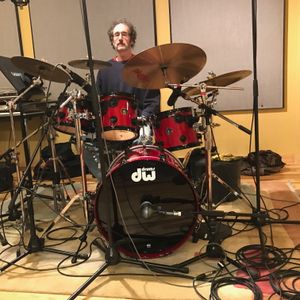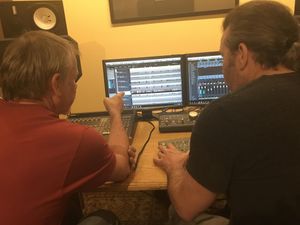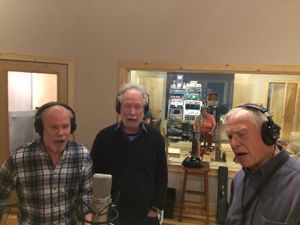

 QCJB in the Recording Studio
QCJB in the Recording Studio
Notably Fine Audio’s facility is in high demand and so is our engineer, Mario Casilio. NFA’s comfortable facilities include four live rooms. Our three horns, piano and banjo are seated in a big room separated by shoulder high padded partitions. Drums, tuba and vocals are each in glass booths. We can all see each other and hear each other with individually balanced headphones. A musician might ask Mario, “May I have more of myself and more piano please?” Each tune is recorded two, three of even four times with us all playing together. After each attempt we adjourn to the control room and listen and comment: “It lacks drive.” “Too fast to swing.” “I don’t like what I’m doing—can we try it again?” We continue working on each tune until we are all pleased. Mario marks the one we like but always keeps everything.
The Mixing Process
Note: It takes at least two or three hours to mix a tune and less than an hour to record one.
The Setting: Mario is at the console with Eric, John, Tony, Bill and other band members when they are available sitting behind on chairs or a comfy couch. On the large computer screen we see about a dozen stacked horizontal windows that represent each of the instruments and Wende’s vocal. These are called tracks. Each track appears as tight vertical squiggles in which each note is a clump of about 6 or 8 squiggles. (These squiggles look like the up and down marks on my wife’s lie detector machine.) As the music plays, a yellow top to bottom vertical line crawls across the screen in time with the playback.
Mario presses a key on his computer keyboard and we start mixing Alexander’s Ragtime Band.
Everyone: Yowie!
Eric: What was that?
Bill: Trombone is on a B and the trumpet is playing a Bb, ouch.
Mario: What do you guys want to do?
Eric: Go back a little and find a trombone Bb.
Mario: How’s this?
Eric: That’s a good one, slip it in right there.
Mario highlights the indicated Bb squiggle clump with his mouse. He then captures copies it and substitutes it for the B that Eric actually played. We listen. “Perfect, thank you, Mario, for enhancing my talent.”
John: “The note is correct, but is it is a little too loud?”
Mario scrunches down the Bb clump with his mouse. We listen again.
Everyone agrees it is perfect, but notices that something in the rhythm section isn’t correct.
Mario isolates the piano, drums, banjo and tuba and we all hear that they are playing the correct chord which is a G7.
Bill: “Okay, now the trombone and trumpet are on the same pitch, but how does the Bb fit into a G7?”
Eric: “A blue note?”
John: “Let’s listen.”
Mario now plays back to whole band including Wende’s vocal. Sure enough the Bb against a G7 sounds perfectly bluesy.
Then we notice something else . . .
John: “All I hear is trumpet behind the vocal in this section.”
Eric: “Mario, can you let us listen to only the three horns in this spot?”
Mario now has just three tracks on the screen and sure enough the trumpet predominates over the trombone and clarinet. In no time Mario etches a line over the clarinet and trombone squiggle clump notes and drags the etched line up. On the next playback the horns are all audible and balanced.
“How about more drums all the way through this tune?”—an easy fix for Mario as is shortening the last note the tuba plays so we all now cut off together. “What is that word you are singing there, Wende?” If we can’t understand a word, Wende can go into the booth and re-record a section.
And so it goes for hour after hour. Why? The main purpose is to create an archive for posterity and produce a product you, our fans. Profits from these recordings are a source of funds to pay us a little and allow us to keep playing and recording. Another huge benefit is musical quality--I can’t tell you how many times someone says, “Hank, what is that chord you are playing there?” “Bb.” “Bb? I have been playing a Gm for years.” This in a tune we have been playing in public for years and never noticed until playback in the studio. When we listen carefully we notice all manner of things that escape our attention during performance like balance and choice of notes. Everything we hear and fix carries over into performance. Authors, poets and painters get to hone their creations before public exposure, but jazz is on-the-spot, played and forgotten in an instant. Our records which always receive rave reviews from national critics both for performance and production really help us grow musically and also urge us to rehearse and learn new material.
